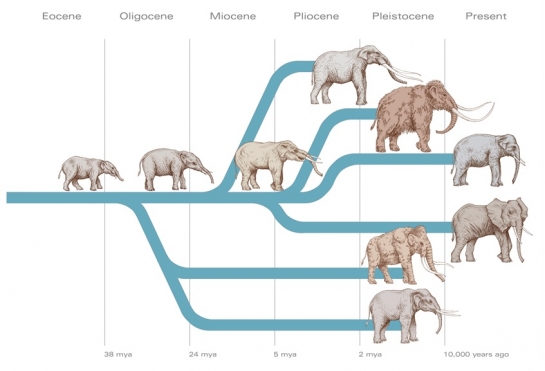Mammoet kies
Mammoet kies
Hallo allemaal,
Een paar jaar geleden heb ik deze mammoet kies gekocht. Ik vroeg me alleen af welke soort het is en hoe oud het ongeveer is. ik vraag het me af omdat de meeste mammoetfossielen die aangeboden worden, van de wolharige mammoet zijn, maar deze kies er echt anders uitziet dan de kiezen die ik zie van de wolharige mammoet. Alvast bedankt voor de antwoorden!
[Bewerkt door Passchier op 07-01-2019 om 19:15 NL]
- FossilDude
- Administrator
- Berichten: 2368
- Lid geworden op: 24 nov 2007, 22:23
- Locatie: Leuven, België
- Has thanked: 327 times
- Been thanked: 310 times
- Contacteer:
Antw: Mammoet kies
Ik ben geen expert, dus wacht voor de meningen van andere af, maar mij doet dit (vooral ook gezien de bewaring) denken aan de kies van een recente (Afrikaanse) olifant.
Van je hobby je beroep maken.... kan het nog beter? ;)
Antw: Mammoet kies
Alvast bedankt voor de antwoorden! Ik hoop dat jullie met deze extra foto misschien meer kunnen vertellen.
- sjaak
- Berichten: 7069
- Lid geworden op: 28 mar 2006, 17:11
- Has thanked: 395 times
- Been thanked: 384 times
- Contacteer:
Antw: Mammoet kies
Lijkt mij ook Afrikaanse olifant. De lamellen zijn ruitvormig en sluiten op elkaar aan.
Zie ook hier: https://www.fossiel.net/forums/viewtopi ... icID=19627
Zie ook hier: https://www.fossiel.net/forums/viewtopi ... icID=19627
Groet,
Niels
Niels
- FossilDude
- Administrator
- Berichten: 2368
- Lid geworden op: 24 nov 2007, 22:23
- Locatie: Leuven, België
- Has thanked: 327 times
- Been thanked: 310 times
- Contacteer:
Antw: Mammoet kies
Jup, ik blijf ook bij mijn eerste inschatting: recente tand van een Afrikaanse olifant. Die lamellen zijn idd typerend. Die donkerbruine band aan de zijkant van de tand is ook kenmerkend voor recente tanden.
Van je hobby je beroep maken.... kan het nog beter? ;)
-
Schouwenburg
- Berichten: 3102
- Lid geworden op: 14 feb 2012, 19:35
- Been thanked: 45 times
Antw: Mammoet kies

Niet een hele nauwe verwant van de mammoet, maar ach hij had ook een slurf
Mooie kies.
https://www.knowablemagazine.org/articl ... could-talk
Marine mammals, dolphinately awesome
- knaapjvd
- Senior Lid
- Berichten: 599
- Lid geworden op: 12 okt 2014, 22:57
- Locatie: Westland
- Has thanked: 13 times
- Been thanked: 15 times
Antw: Mammoet kies
Onderschrift behorende bij die plaat.
"Nine species are named over six geologic time periods from 55 million years ago to the present. The ancestor species is Palaeomastodon (far left, in the Eocene), which evolves into Gomphotherium (in the Oligocene) and then Primelaphus (in the Miocene). This main line leads to Elephas (the Asian elephant) and Loxodonta (the African elephant) in the present (far right). Mammut (the mastodon) and Stegodon evolve in the Oligocene, becoming extinct in the Pleistocene (lower right). Anancus evolves in the Miocene, becoming extinct in the Pliocene (upper right). Mammuthus (the mammoth) evolves in the Pliocene and becomes extinct in the Pleistocene (upper right)."
Source: https://www.sciencephoto.com/media/9368 ... on-diagram
[Bewerkt door knaapjvd op 10-01-2019 om 17:59 NL]
"Nine species are named over six geologic time periods from 55 million years ago to the present. The ancestor species is Palaeomastodon (far left, in the Eocene), which evolves into Gomphotherium (in the Oligocene) and then Primelaphus (in the Miocene). This main line leads to Elephas (the Asian elephant) and Loxodonta (the African elephant) in the present (far right). Mammut (the mastodon) and Stegodon evolve in the Oligocene, becoming extinct in the Pleistocene (lower right). Anancus evolves in the Miocene, becoming extinct in the Pliocene (upper right). Mammuthus (the mammoth) evolves in the Pliocene and becomes extinct in the Pleistocene (upper right)."
Source: https://www.sciencephoto.com/media/9368 ... on-diagram
[Bewerkt door knaapjvd op 10-01-2019 om 17:59 NL]
Groeten,
Joost
Joost